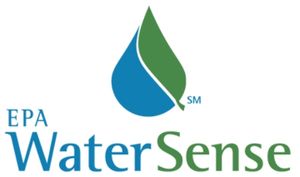
Showers account for 18 percent of residential indoor water use.[1] When you consider that the United States uses nearly 1.2 trillion gallons of water a year just for showering,[2] it is easy to see why low-flow showerheads can have a big impact on water consumption and efforts to conserve water at home. (To put this figure in perspective, 1.2 trillion gallons is enough water to supply the water needs of New York and New Jersey for an entire year!)[2]By simply switching to a low-flow showerhead, everyone can participate in water and energy conservation.
Low-flow showerheads once had a reputation for being wimpy, pathetic, and just down-right unbearable; however, nowadays, choosing a low-flow showerhead no longer means having to give up what you want in a showerhead, which is, as Kramer from "Seinfeld" puts it,"POWER Man, POWER!"The evolution of low-flow showerheads was brought about by a growing need for water conservation in concert with advances in showerhead technology. In recent years low-flow showerheads have come a long way; be assured, nonbelievers, the low-flow showerheads of today are as effective and satisfying as the traditional wasteful models.
The advantages of low-flow showerheads have been recognized by government and environmental organizations alike. Today more groups are pushing for low-flow showerheads and other water conservation techniques. For example, the WaterSense program, launched by the EPA in 2006, reduces water consumption at the residential level.[3] WaterSense has made it easier for households to choose high-performance low-flow showerheads and other water-efficient products that are guaranteed to meet or beat the expectations of water-hungry consumers.[4]
Included in this page are resources that will aid anyone looking to upgrade to a low-flow showerhead. The DIY resources section contains links to articles for installing shower heads and testing the efficiency of your current showerhead. Also provided are links to programs that advocate and research low-flow showerheads and retail websites for price comparison.
Relevant US federal programs[edit | edit source]
Congress passed the Energy Policy Act (EPAct) in 1992, which established production standards for water efficiency, effectively outlawing all plumbing fixtures in the U.S. which did not meet the prescribed benchmarks.[5] Before the EPAct, normal showerheads sprayed water between 5 and 8 GPM. The EPAct set the national standard at 2.5 GPM, hoping to halving shower water consumption.[1] The limitations on showerhead spray, particularly, were met with public disapproval. Many Americans complained that decreased shower head flow would not allow adequate pressure to wash out shampoo or relieve stress. This social stigma surrounding low-flow showerheads led manufacturers to find creative ways to circumvent the new national regulations. Some manufacturers even went so far as to put directions on removing the flow restrictor piece from their shower heads on the packaging.[1] Thus, while federal law requires that all showerheads have a GPM rating of 2.5 or under, many Americans continue to consume more than the legal limit by removing the small washers in their showerheads that restrict flow or even installing more than one shower head in their showers.
The U.S. Environmental Protection Agency (EPA) launched its WaterSense Program in 2006 to encourage consumer awareness for water-efficient products. In partnership with independent third-party organizations, WaterSense tests and certifies home products that meet its water efficiency criteria. Some of these criteria include: products are 20% more efficient than other products in the same category, realize water savings on a national level, and work as well or better than comparable, less-efficient alternatives. In addition, WaterSense has performance criteria to ensure that showerheads are efficient and work well. Starting in 2010, WaterSense labels appear on low-flow showerheads and bathroom sink faucets, toilets, and urinals.[2] It is important to note, however, that WaterSense considers low-flow showerheads to have a GPM of 2.0 or less. For more information on the EPA's WaterSense Program
Impacts[edit | edit source]
Water is the quintessential liquid that supplies all living beings with the hydration necessary to survive. Unfortunately, in our modernized homes, it is easy to forget that the water flowing from the tap originated in riparian ecosystems or underground aquifers that are being severely impacted by our casual overuse of water. Indeed, in the United States alone, we consume approximately 340 billion gallons of water from streams, reservoirs, and wells every day.[6] While a great majority of that water goes to crop irrigation, the easiest way we can make a difference in water consumption rates is within our homes.
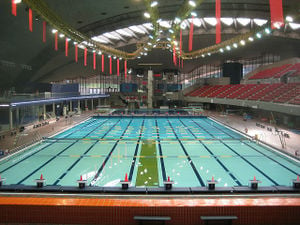
Showers account for 18% of indoor water use in American homes.[6] The average American showers every day for about eight minutes, consuming 20 gallons of water.[1] Since 1992, federal regulations have required that manufacturers produce shower heads with maximum gallons per minute (GPM) ratings of 2.5 GPM. By switching to a WaterSense approved showerhead, an eight-minute shower would consume 16 gallons of water, a 20% reduction from the standard.[1] If an individual showered every day, using a 2.0 GPM shower head would lead to 1,460 gallons of annual water savings. However, going one step further and changing to a low-flow showerhead with a 1.6 GPM rating would save 7.2 gallons a day and 2,628 gallons a year compared to a standard 2.5 GPM showerhead. Multiply that by the number of residents in your home, and the savings in water consumption and cost add up! Then, consider the savings on a national level: Let's assume there are about 300 million people in the US. 2,628 gallons x 300 million people= 788 billion gallons of water saved in a year! That much water could fill more than one million Olympic-sized swimming pools.
Technology[edit | edit source]
Showerhead Flow Restrictors (Disk Inserts)[edit | edit source]
Flow restrictors are small (about the size of a U.S nickel or quarter) plastic or metal discs used within showerheads to limit the amount of water passing through the unit. (See photo)
Flow restrictors are typically seen in older fixtures.[8]
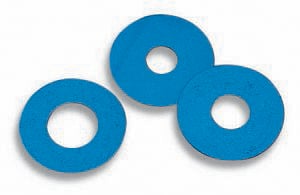
Flow restrictors are an inexpensive tool used mostly to convert older high-flow showerheads to conform to the laws requiring lower flow rates. The problem with flow restrictors comes from how the shower heads operate under these choked conditions; these models were not originally designed to function properly with these lower flows. The result is typically a meager and inadequate shower. It has been noted by those who study low-flow showerheads that disc inserts have a poor acceptance rate by bathers and are typically not used by experienced conservation managers.[8] The solution for most consumers, as noted above, is to remove the flow restrictor, which defeats all efforts to conserve water and permits illegal flow rates in the U.S.
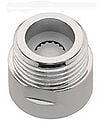
Showerhead flow restrictors are not advised; flow restrictors often lead to the dreaded weak and insufficient shower. Flow restrictors coupled with poor engineering are the major reason low-flow showerheads once had a reputation for providing a poor shower.
When purchasing a low-flow showerhead, avoid units that achieve flow rate through a flow restrictor; high-quality models generally do not contain a removable restrictor disc and rely instead on technological advancements in showerhead aeration other innovations.
Aeration[edit | edit source]
Aeration (also called aerification) is the process by which air is circulated through, mixed with, or dissolved in a liquid or substance;[11] in a shower-head, aeration works by combining air into the water stream.
Due to its higher oxygen content, aerated water is lighter and also less dense than non-aerated water. Aerating water increases the volume of the water, making the droplets of water smaller and thus able to cover more area; essentially, with aerated water, less water can be used to wet the same surface. According to Dr. Jie Wu, a leading developer behind showerhead technology, aeration makes the water more like wet pockets of air, "Through aeration, we make the water droplets in the stream hollow and the bubbles expand the volume of the shower stream."[12]For the bather the aerated water gives the same sensation and satisfaction as non-aerated water. Aeration is the most popular and efficient method of reducing water consumption in showerheads; aeration alone can reduce water consumption by up to 30 percent.[13]
Showerheads aerate the water through two techniques.

The first is turbulence within the showerhead which effectively mixes the water with air. The second is an ingenious implementation of the Venturi tube. The Venturi tube creates a vacuum within the showerhead; the vacuum sucks air into the unit infusing the oxygen with the water stream. For more information on the science behind the Venturi tube, click here
A criticism of aeration has come from the fact that aerated water loses heat faster than non-aerated water. Alan Meier noted this effect in a column for Home Energy Magazine On-Line, "Aeration is often used in the low-flow showerheads to give them extra body, but it results in rapidly declining temperature between the time the water leaves the showerhead and hits the body."[15] The disapproval arises from the fact that more hot water is used; Meier claims, "Without knowing it, many users raise the temperature of the water 1 deg. F to 10 deg. F to maintain the same 'impact temperature.'"[15] The Pennsylvania State University, however, has come out against this criticism, stating in an article titled "Household Water Conservation," slightly hotter water does not negate the substantial savings achieved by low-flow showerheads.[16]
Pressure Compensating Flow Regulator[edit | edit source]
A pressure compensating flow regulator essentially functions by expanding and retracting a particular O-ring against a precision profile. In this way, the flow opening automatically changes depending on the distribution pressure.[17] This flow regulator allows the showerhead to adjust to the specific water pressure of the place where it is installed.
The pressure compensating flow regulator is a feature on low-flow showerheads, allowing the showerhead to maintain the same flow rate over various water pressures. Many low-flow manufacturers believe that failure to incorporate such a mechanism will result in a disappointing showing experience for many users.[15]
The best shower head designs deliver nearly identical flow rates within the typical 40-80 PSI pressure range. For example, the Evolve Roadrunner 1.59 GPM shower head has less than a 6% flow variance within this pressure range.[18]
On-Off Switches and "SmartStart"[edit | edit source]
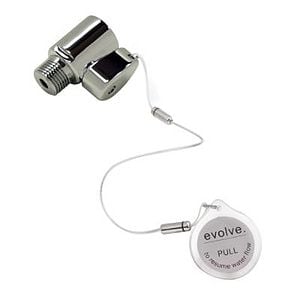
Another innovation used in many low-flow showerheads is a simple 'on-off switch located on the showerhead itself. These switches allow users to pause the water flow while washing their hair or lathering. While this innovation does not lower the rate of water exits the showerhead, it still can conserve water.
SmartStart, on the other hand, is an innovation that allows the user to run the water only long enough to warm up before they get in the shower. So if you are the type of person who turns on the shower before you get in to allow the water to warm up, this could help you save water. The technology knows when the water reaches bathing temperature and shuts off automatically. When you are ready for your shower, there is a simple lever to resume the water flow.[20] For more info on SmartSmart click here
Products[edit | edit source]
Today there are many excellent low-flow showerheads on the market. Quality low-flow showerheads start around $25.
Check out WaterSense's product search page for the most up-to-date information regarding highly efficient and high-performing showerheads.
What to look for in a low-flow shower head[edit | edit source]
- Clearly-marked maximum GPM flow rate
- WaterSense certification logo
- WaterSense products are tested for the following criteria
- Water efficiency
- Spray coverage
- Spray force
- WaterSense products are tested for the following criteria
- No removable flow restrictor
- Features such as
- Aeration
- A pressure compensating flow regulator
- On-Off Switches and "SmartStart."
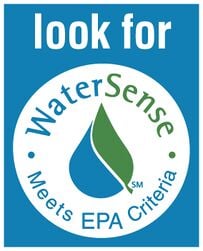
Highly rated 1.6 GPM or less low-flow shower heads on the market[edit | edit source]
Alsons Water Amplifying Shower Head (658)
- WaterSense approved
- 1.5 GPM maximum flow rate
- Comfort spray setting
Average Cost: $26

Delta Transitional Water-Efficient Showerhead
- WaterSense approved
- 1.6 GPM maximum flow rate
- Lifetime faucet and finish warranty
Average Cost: $60
Evolve RoadRunner
- 1.5 GPM maximum flow rate
- Pressure compensating technology
- Full face spray pattern
Average Cost: $40
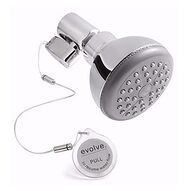
Bricor EcoFIT
- 1.25 GPM @ 50psi
- 50% solid brass and 50% chromed ABS material with a Neoprene spray plate
- Patented aeration
Average Cost: $25

Oxygenics 630-XLF
- 1.5 GPM Maximum flow rates
- Patented aeration
- Pressure compensating technology
Average Cost: $25'
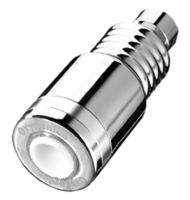
DIY Resources[edit | edit source]
How to determine the flow rate of your current shower head[edit | edit source]
Inspired by Paul Scheckel's "The Home Energy Diet"[25]
- Turn on the shower how you usually would when you take a shower
- Using a one-gallon jug and a watch with a second-hand, time how long it takes to fill the jug under the flow of your shower head.
- Do the math to calculate your flow rate; if it takes 60 seconds, that's one gallon per minute!
GPM = 60 (number of seconds in a minute) / how many seconds it took to fill a one-gallon container
| Number of seconds to fill | Using a Quart jug | Using a Gallon Jug |
|---|---|---|
| 3 | 5.00 | 20.0 |
| 4 | 3.75 | 15.0 |
| 5 | 3.00 | 12.0 |
| 6 | 2.50 | 10.0 |
| 7 | 2.14 | 8.60 |
| 8 | 1.88 | 7.50 |
| 9 | 1.67 | 6.70 |
| 10 | 1.50 | 6.00 |
| 12 | 1.25 | 5.00 |
| 15 | 1.00 | 4.00 |
| 20 | 0.75 | 3.00 |
| 30 | 0.50 | 2.00 |
| 40 | 0.38 | 1.50 |
| 50 | 0.30 | 1.20 |
| 60 | 0.25 | 1.00 |
Conclusion[edit | edit source]
As the population continues to grow and impending global climate change brings new environmental challenges, water demand will also increase in the future. Indeed, research indicates water demand is currently exceeding supply, making conservation efforts crucial if we hope to maintain a good water source. Rolston St. Hilaire (2009) of New Mexico State University asserts, "The lack of water has the potential to jeopardize our food supply, disrupt fragile ecosystems, alter alliances among constituents, and threaten our way of life."[26] Thus, to avoid the possibly catastrophic consequences of squandering our much-needed water supply, the public must assume an active role in conservation. Helen Ingram (2009) of the University of California-Irvine reports that following extensive studies on local, regional, and global water use, a team of scientists concluded that, "A crucial part of the path to water conservation involves paying close attention to the dimensions and scales that define how people interact with and understand water."[27]
In essence: start small. Changing your showerhead to a low-flow alternative is a quick and easy way to start on the personal path to water conservation. Federal programs like the EPA's WaterSense make low-flow showerheads accessible. At the same time, new technologies like water aeration devices and screw turbines give low-flow showerheads comparable pressure to the luxury of higher GPM heads. If you are building or remodeling a deluxe new bathroom, top-end premium showerheads can meet your spa-like needs. On the other hand, if you are attempting to retrofit your home to save money, simply add-on kits make updating your shower head a logical, inexpensive option.
References[edit | edit source]
- ↑ 1.0 1.1 1.2 1.3 1.4 Ball, Jeffrey. "Under Pressure: Bathers Duck Weak Shower Heads; Water Shortages Spur Restrictions and Low-Flow Designs but Some Aren't Willing to Sacrifice and Skirt the Rules." The Wall Street Journal, Eastern Ed. Vol. 254 Issue 115 pA18.
- ↑ 2.0 2.1 2.2 EPA shower heads
- ↑ https://www.epa.gov/watersense
- ↑ https://www.epa.gov/watersense/watersense-partners
- ↑ Benazzi, Robert. "Water Conservation Protocols." Buildings 103 no. 10 Oct. 2009.
- ↑ 6.0 6.1 Johnson, David, and Kim Master. Green Remodeling: Changing the World One Room at a Time. New Society Publishers. Gabriola Island, Canada. 2004.
- ↑ http://www.flickr.com/photos/jonathanziapour/2613204502/
- ↑ 8.0 8.1 http://web.archive.org/web/20100713160918/http://www.clallam.net/environment/assets/applets/W18d1_Appendix2-D-WaterConservationMeasures.pdf
- ↑ http://frugalmechanic.com/auto-parts/weiand/cooling-system-water-pump
- ↑ http://www.eco-builder.co.uk/category/water-saving-devices/
- ↑ http://wordnetweb.princeton.edu/perl/webwn?s=aerate
- ↑ http://web.archive.org/web/20210117132129/https://www.csiro.au/news/ShowerHead.html
- ↑ http://www.physorg.com/news82299918.html
- ↑ http://www.peteducation.com/article.cfm?c=16+2148&aid=2825
- ↑ 15.0 15.1 15.2 http://www.screamtobegreen.com/wp-content/uploads/2008/04/choose-shower-head.pdf
- ↑ http://pubs.cas.psu.edu/freepubs/pdfs/uh164.pdf
- ↑ http://web.archive.org/web/20090601064136/http://www.aquaclic.co.za:80/show_sub.asp?id=1235
- ↑ http://web.archive.org/web/20150201144926/http://evolveshowerheads.com:80/roadrunner_showerhead.html
- ↑ http://planbredesign.com/page/3/
- ↑ http://web.archive.org/web/20150321043550/http://evolveshowerheads.com:80/technology.html
- ↑ [https://web.archive.org/web/20110307232 http://web.archive.org/web/20110307232
- ↑ showerhead.html http://web.archive.org/web/20150201144926/http://evolveshowerheads.com:80/roadrunner showerhead.html
- ↑ http://web.archive.org/web/20110323115137/http://www.bricor.com/products/ecofit/
- ↑ http://web.archive.org/web/20110902230947/http://www.oxygenics.com:80/skincare-shower.php
- ↑ Paul Scheckel,"The Home Energy Diet," 2005. New Society Publishers. Gabriola Island, BC, Canada.
- ↑ St. Hilaire, Rolston. "The Residential Urban Landscape as a Frontier for Water Conservation." Proteus 26 no. 1 Spring 2009. p15.
- ↑ Ingram, Helen. "Water Use: Local, Regional, and Global Considerations." Environment 51 no. 3 May/June 2009.
External links[edit | edit source]
- WaterSense Product Search:Here is a list of all the products currently certified through the WaterSense program.
- DIY tips for installing shower heads
- EPA New Home Builder Resource Manual: This resource manual is helpful for more than just upgrading your showerheads.
- Energy.Gov Energy Cost Calculator for Faucets and Shower heads
- Online Shower Head Retailer:This website specializes solely in showerheads and can be useful for checking prices and products specs.